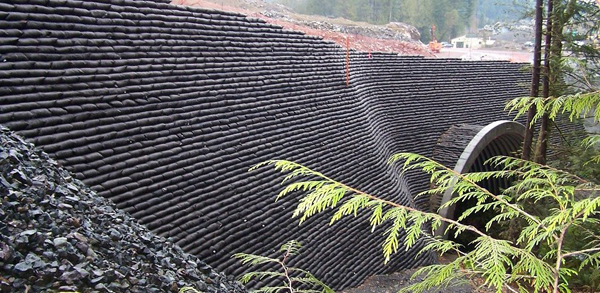
I have to laugh when people keep asking me if earthbag building is strong. Earthbags (sand bags) have centuries of use by militaries worldwide, because they’re bomb, blast and bullet resistant. Millions of sand bags are used each year for flood control to stop raging rivers. As well, earthbag building is earthquake and hurricane resistant.
Massive earthbag retaining walls like the one in the photo above are now fairly common. The US Department of Transportation uses so many polypropylene sand bags for retaining walls along highways that they did an accelerated aging test to help determine the lifespan. The study showed polypropylene bags protected from sunlight may last over 500 years, and there is no effect from moisture. See my Earthbag Building ebook and DVD for details and complete step-by-step building information.
Image source: Flexmse.com

Hi thank you in advance can we use these as permanent flood protection wall (for very high flood about 3-4metre flood depth)
Just curious to know if in Canada you would use a footing underneath a retaining wall made of earthbags. The wall is 9 feet high.
Thanks
I don’t think that a footing is generally required under a retaining wall, especially if adequate drainage is established behind it, with weep holes, etc.
Hey folks –
A compacted footing of granular stone is NCMA best practice for all retaining walls, especially for larger ones. As a note, any wall over 4ft in height, or that has loading/surcharge, needs a building permit and a stamped set of engineered drawings.
Cheers
I will put new soil on my plot before I build a house. I live in Thailand. I want to build a 60 cm underground retaining wall, so that the soil doesn’t wash away to the neighbors. Should I use gravel or sand ? Good idea to plant bushes near so that roots link-in ?(p.s. Thai builders insist on 3000$ concrete underground wall)
I think you could use either sand or gravel effectively for such a short retaining wall. Plantings in the area would also help retain the soil.
What did they use for UV protection here?
Thinking of using for a 4 metre high retaining wall:
Rebar and drain pipes, with additional concrete post and anchors if necessary.
Temporary UV protection with regular, cheap paint
Final coat with regular cement plaster
The wall will eventually be furnished with vines and other vertical perennials.
Will this work? Do any experts out there have any concerns?
What kind of bags are they using in this photo?
It looks like regular earthbags. They come in lots of different colors, strengths, sizes, etc.
These are made from a proprietary non-woven polypropylene material.
Thank you for your hard work.
Dear Owen,
Thank you for your continued hard work in promoting EBB and helping the greater community.
Question regarding the EB retaining wall. What do you think these bags were covered with to help with protection from the UV rays? Do you have other suggestions from what they have used as well?
All best.
It’s hard to say because we don’t know what the final retaining wall looks like. These bags are probably industrial spec with high UV rating. Maybe the bags are covered with mesh, more soil and plants? I don’t know.
What would be the most cost/durability effective solution for long-term UV protection?
Again: These bags are probably industrial spec with high UV rating. Maybe the bags are covered with mesh, more soil and plants? I don’t know.
The most affordable solution is to build quickly (within a few weeks), get the roof on and first coat of plaster as soon as possible. Next best would probably be to apply a thin coat of recycled latex paint.
Hi Owen –
I work for the company that manufactures this vegetated wall system, and worked on this project. This, and most, of our walls and slopes are hydroseeded with a high tenacity mulch product, tackifier, and grass seed. You can also live plant directly into the engineered soil inside. The vegetation quickly grows in to cover the facing. As you said, once covered, the Geosynthetic material lasts essentially forever.
For the purposes of this group – plaster would certainly be the first choice, since you’re not adding any organics to the Bag fill. Also, vegetation isn’t practical in all applications. Completely vertical walls are more challenging to vegetate, and usually require irrigation for best results, which may not be suitable for every project.
We haven’t got into the home building space much – mostly retaining walls for roadways, buildings, river bank erosion, etc. But we love earth bag, and earth embedded building!:) You can check out more of our installations on Instagram @flexmse.